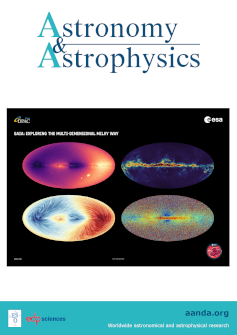Central galaxy alignments
IF 5.8
2区 物理与天体物理
Q1 ASTRONOMY & ASTROPHYSICS
引用次数: 0
Abstract
Context. Observations indicate that central galaxies’ main shape axes are significantly aligned with other galaxies in their group, as well as with the large-scale structure of the Universe. Simulations have corroborated this finding, providing further insights into how the shape of the stellar component aligns with the surrounding dark matter halo. Recent studies have also investigated the evolution of this alignment in bright central galaxies, revealing that the shapes of the dark matter halo and the stellar component can differ. These results suggest that assembly and merger processes have played a crucial role in the evolution of this alignment.Aims. In this work, we aim to gain a deeper understanding of galaxy alignments by quantifying how this property is related to the mass of the halos hosting central galaxies and to the large-scale environment measured at different scales.Methods. By studying different angles, we describe how the alignments of central galaxies depend on the masses of the halos they inhabit. We explore how the main axes of central galaxies align across different scales, both in three-dimensional and two-dimensional projections. We examine how halo mass influences these alignments and how they vary in the surrounding large-scale environment. Additionally, we analyse the characteristics of these alignments across different environments within the large-scale structure of the Universe. To conduct this study, we employed TNG300 hydrodynamical simulations and compared our results with spectroscopic data from the Sloan Digital Sky Survey Data Release 18 (SDSS DR18).Results. Three types of alignment were analysed: between stellar and dark matter components, between satellite galaxies and the central galaxy, and between the central galaxy and its host halo. The results show that the alignment increases with halo mass and varies with the environment (cluster, filament, cluster outskirt, and others). However, after controlling for local density, we found that most of the observed trends disappear, except for a marginal influence of cosmic filaments on some of the considered alignment angles. The SDSS observations confirm a mass dependence similar to the simulations, although observational biases limit the detection of differences between the different environments.中央星系排列
上下文。观测表明,中心星系的主要形状轴与它们所在星系群中的其他星系以及宇宙的大尺度结构明显对齐。模拟证实了这一发现,为恒星成分的形状如何与周围的暗物质晕对齐提供了进一步的见解。最近的研究还调查了明亮的中央星系中这种排列的演变,揭示了暗物质晕和恒星成分的形状可能不同。这些结果表明,组装和合并过程在这种对齐的演变中发挥了至关重要的作用。在这项工作中,我们的目标是通过量化这种性质如何与中心星系的晕的质量以及在不同尺度上测量的大尺度环境相关,从而对星系排列有更深的了解。通过研究不同的角度,我们描述了中心星系的排列如何依赖于它们所居住的光晕的质量。我们探索中心星系的主轴如何在不同的尺度上排列,包括三维和二维投影。我们研究了光晕质量如何影响这些排列,以及它们如何在周围的大尺度环境中变化。此外,我们分析了这些排列在宇宙大尺度结构中不同环境中的特征。为了进行这项研究,我们使用了TNG300流体动力学模拟,并将我们的结果与斯隆数字巡天数据发布18 (SDSS DR18)的光谱数据进行了比较。分析了三种类型的排列:恒星和暗物质成分之间的排列,卫星星系和中心星系之间的排列,以及中心星系和它的宿主光晕之间的排列。结果表明,光晕的排列随光晕质量的增加而增加,随环境(星团、长丝、星团外围等)的变化而变化。然而,在控制了局部密度之后,我们发现除了宇宙细丝对某些考虑的对准角的边际影响外,大多数观测到的趋势消失了。SDSS观测证实了与模拟类似的质量依赖性,尽管观测偏差限制了对不同环境之间差异的检测。
本文章由计算机程序翻译,如有差异,请以英文原文为准。
求助全文
约1分钟内获得全文
求助全文
来源期刊

Astronomy & Astrophysics
地学天文-天文与天体物理
CiteScore
10.20
自引率
27.70%
发文量
2105
审稿时长
1-2 weeks
期刊介绍:
Astronomy & Astrophysics is an international Journal that publishes papers on all aspects of astronomy and astrophysics (theoretical, observational, and instrumental) independently of the techniques used to obtain the results.
 求助内容:
求助内容: 应助结果提醒方式:
应助结果提醒方式:


